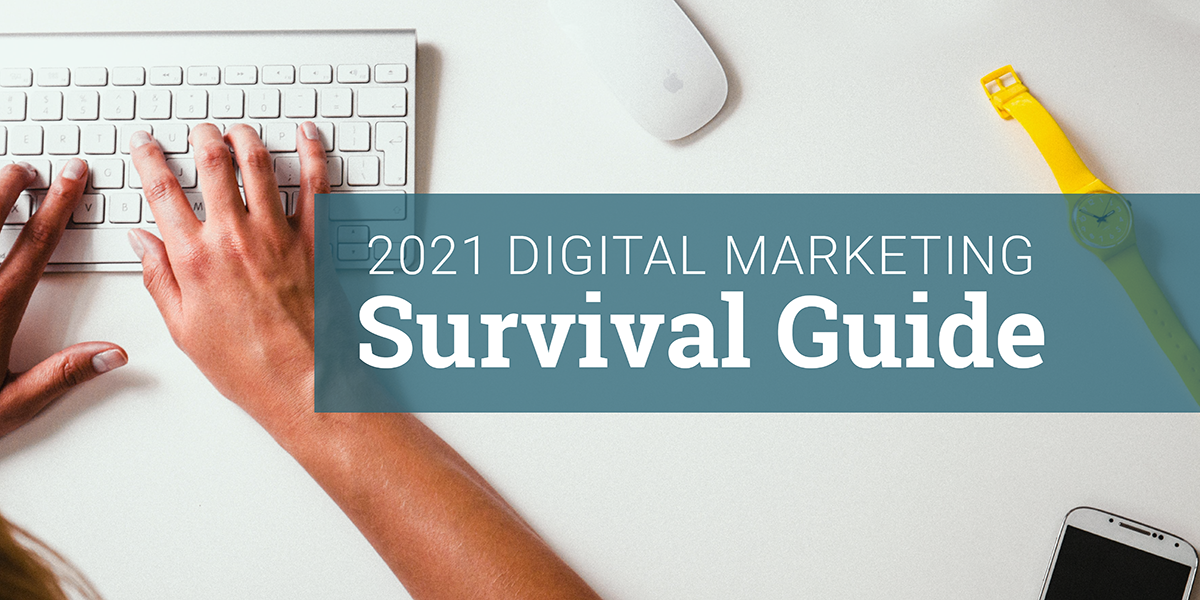A 2021 Digital Marketing Survival Guide for Nonprofits & Thoughtful Brands
Lisa Hirst Carnes | January 2021

After a chaotic 2020, businesses and organizations are wondering what may be in store for them in the coming year. Whatever 2021 may bring, it’s certain that digital marketing is going to play a crucial role. When many people are working at home, travel is restricted and live events must be reinvented as virtual events, you need to be more adaptable than ever before. In this guide, we’ll look at how creative brands and nonprofits can prepare for 2021.
A Review of the Current Situation
The events of 2020 have disrupted just about every aspect of life. The pandemic and its effects have certainly had an impact on how businesses and nonprofits operate.
- Remote work became the norm. Practices such as offering employees flexible hours and hiring remote workers and outsourced contractors were already trending before the pandemic. As Business2Community reports, the number of people working remotely increased by 44% in the last 5 years. However, in 2020, many organizations were forced to switch entirely to this model.
- Economic hardship. The pandemic resulted in many businesses closing and people losing their jobs. Even businesses that remained open were hit hard and had to reduce their hours and services. This also puts a strain on nonprofits and other organizations that depend on donations and paid memberships.
- Competition in nonprofit space. During challenging times, resources become increasingly scarce. Nonprofits are having to compete in an environment where people have less discretionary income. They may also have less time to engage in volunteer activities.
These factors are combining to create an increasingly challenging and competitive environment, which is making digital marketing ever more critical.
Why Digital Marketing is Vital
The rise of digital marketing, like remote work, certainly didn’t begin in 2020. However, when the internet is often the only way to reach your audience, it becomes more important than ever. Several factors set digital marketing apart.
Cost-Effective
One of the main advantages of digital marketing is that it provides better value than traditional types of marketing. This is mainly because you can reach a large audience using techniques such as email marketing, social media, and PPC advertising. Many digital marketing tactics are very cheap to implement. Even paid digital ads are often more cost-effective than traditional paid advertising due to better targeting options, which brings us to the next point.
Easier to Reach Your Audience
The ability to reach a large and targeted audience is probably the single most impressive benefit of digital marketing. With pay-per-click ads, for example, you target specific keywords that your audience is searching for. On social media sites, you can target people by profession, gender, age, interests, and other criteria. The contrast between traditional and digital marketing overlaps with another distinction, inbound vs outbound marketing. Traditional outbound marketing such as TV commercials, print ads, cold calling, and direct mail is expensive and not well targeted. Inbound marketing, on the other hand, focuses on providing people with helpful information that motivates them to contact you.
Measurable
Digital marketing makes it easy to track your results. You can use free tools such as Google Analytics to track metrics such as traffic, conversions, time spent on web pages, and much more. Social media sites all have their own tracking tools such as Facebook Analytics and Twitter Analytics. Email marketing services such as MailChimp and AWeber have their own built-in analytics as well.
One of the most valuable types of testing you can do on digital platforms is the split or A/B test, where you can test specific variables such as your headline, image, or call-to-action. This type of testing lets you tweak your approach for better results. Tracking results with traditional advertising is much slower and more complicated, making it harder to see what is and isn’t working.
An Overview of the Top Digital Marketing Strategies
Let’s look at the most effective digital marketing strategies that will continue to be relevant in 2021.
Content Marketing
Content marketing is essential for many reasons. It builds brand recognition. It lets you establish yourself as an authority in your niche or industry. It’s a cost-effective way to get leads. There are many ways to leverage the power of content marketing.
- Blogging —a blog helps bring traffic to your website. Blogging is an effective SEO tool, especially if you target certain topics and keywords with each post.
- Videos —Videos are getting more popular all the time. You can post videos to your website, YouTube, and social media pages.
- Podcasts —Podcasting is another rising trend that’s reaching a wider audience every year. You can share news about your business or organization, interview experts, and discuss upcoming news.
- Webinars and live streams. Interactive content is another great way to connect with your audience. Webinars can be used for sharing information about your organization, fundraising, conducting interviews, or Q & A sessions.
Search Engine Optimization (SEO)
SEO is closely related to content marketing as it’s your content that you’re trying to rank. SEO is a rapidly changing field, largely based on Google’s latest policies and algorithms. Here are some points that are especially important right now.
- Pay attention to local SEO — for any business or organization with a physical location, it’s extremely important to have an optimized Google My Business listing. This helps people find you via Google Maps, tells them what you’re all about, and lists and reviews. Although it’s called Google My Business, it can also be used by other organizations such as churches, schools, and nonprofits.
- Write for people first. Google increasingly rewards websites that demonstrate authority and provide the best resources for searchers. As Search Engine Journal explains, the three pillars of SEO are authority, relevance, and trust. Notice that they don’t mention keyword density, anchor text, or other traditional SEO elements. It’s not that you should abandon such practices. It’s still useful to think of keywords your audience is searching for. However, it’s far more important to deliver useful and informative content.
- Improve on-page SEO. Make sure your website is easy to navigate. Another on-page SEO factor is internal linking, which also helps to keep visitors on your site longer.
- Improve off-page SEO. Listings in local and national directories help you get valuable backlinks to your website. Another way to get links is to send out press releases about upcoming events.
Social Media Marketing
Social media remains one of the best ways to connect with your customers, supporters, or donors. Choose the platforms where your audience is most active. You can combine organic content with paid advertising. Don’t overlook some newer and more popular features on sites such as Facebook and Instagram. Stories are a good way to engage people with timely content. Live-streaming on Facebook, Instagram and YouTube is also good if you want to connect with your audience in real-time.
SEM and Paid Advertising
Search engine marketing (SEM) can be a solid investment if you’re looking for a way to get targeted traffic quickly. Paid ads are an effective way for businesses to generate leads. They also work for nonprofits that want to attract new members and donors. An ad can also publicize an upcoming event such as a fundraiser. You can consider many types of advertising. Here are some guidelines to keep in mind.
- Share your story. Nonprofit organizations need to convey the importance of their activities and keep the public updated on the latest news and developments. It’s important to connect the dots and let potential donors know how their contributions make a tangible difference. Creative brands should also focus on storytelling. You might, for example, use sponsored content such as videos that communicate the purpose of your brand.
- Use Google For Nonprofits. Google also has a special feature called Google For Nonprofits that has many useful resources, including free advertising credits. This is a suite of services worth studying as it can help nonprofits advertise and get publicity for free or at greatly reduced rates (compared to typical Google Ads and other paid advertising).
- Try social media ads. Advertising on Facebook and other social media sites can complement your other social media activities, driving traffic to your pages and posts.
Email Marketing
Email marketing is one of the oldest types of online marketing yet still very relevant. Demand Metric found that email marketing has a ROI of 122%, which is quite a bit higher than other promotional tactics such as PPC and social media. The great advantage of an email list is that it provides you with a way to stay in touch with your subscribers without having to advertise. Of course, you do need to promote to build your list.
An engaging newsletter is one of the most powerful tools for a nonprofit or creative brand. You can make it look professional and consistent with your branding by using templates and interesting images. What’s even more important is to deliver compelling content. This gets back to the importance of storytelling. Your emails are also useful for sending traffic to your website and social media pages.
Events
2020 was the year when many live events were either canceled or re-imagined as virtual events. It looks like this trend will continue well into 2021. Fortunately, there are some key advantages to virtual events. They are cheaper to organize. They let you reach a wider audience as geography is no barrier.
- Choose the right platform. You want to make it as easy as possible for people to register and join your event. Make sure the platform is compatible with all devices and browsers.
- Have clear calls-to-action for raising money. You can sell tickets to the event or make it free to attend. During the event, you can raise money by soliciting donations or holding an auction. No matter how you set it up, make it easy for people to donate and provide frequent reminders.
- Promote the event everywhere. Use all the marketing strategies discussed above to promote it such as paid ads, email, social media, videos, etc.
- Create a dedicated web page for the event. This way, you aren’t sending visitors to your home page and making them locate information about the event.
Digital Marketing Traps to Avoid
There are certain pitfalls to avoid with digital marketing. These mistakes can cost you money and convey the wrong messages to your audience.
Marketing without a Strategy
You need a strategy for your marketing campaigns. This includes clear goals for your actions. For example, before you advertise, create content, or post on social media, you should identify your objective. This may be to drive traffic to a certain landing page, build brand awareness, and get people to sign up for your newsletter, or attend your event. Without a strategy, you have no focus and there’s no way to measure your results.
Lack of Expertise
It’s important to be familiar with the tools and platforms you’re using. If you’re just starting in a certain type of marketing, take the time to research your strategy. If you’re posting on a certain social media platform, make sure you know what the audience expects. For example, users on Instagram tend to be younger, visually-oriented, and prefer entertaining content whereas LinkedIn is a platform for B2B marketing where users expect more data and a business-oriented approach.
Not Measuring Your Results
We already mentioned that one of the benefits of digital marketing is that you have many ways to measure your results. If you don’t track your results, you won’t know what’s working and what you need to improve. It’s important to track as many metrics as possible for each campaign.
Roles and Responsibilities
To execute successful marketing campaigns, you need to allocate tasks and responsibilities so that everyone knows their role. In most organizations, you’ll assign tasks to a variety of individuals and departments based on their experience and expertise. This includes areas such as:
- Content creation and SEO.
- Updating the website.
- SEM and paid advertising.
- Social media.
- Email marketing.
- Event planning.
Depending on the size of your organization, you may have separate departments for one or more of the above. In some cases, tasks may overlap. People handling different tasks must stay in touch. If one person is creating the email newsletter, they should be informed about upcoming events to write about. The same goes for anyone creating blogs, videos, or social media posts.
Getting Started: Planning and Execution
Here are the steps you need to get started with your marketing campaigns.
Outline Your Goals
As we mentioned, you need a strategy for every marketing action. Create an outline of short, medium, and long-term goals. Create goals for each type of marketing. For example, you may be using blogging for SEO and traffic, social media for brand awareness and paid advertising to build your email list.
Determine Your Budget
You need to allocate funds for different areas of your marketing campaigns. This may include outsourcing costs for building a website, advertising, purchasing software or services, and any other expenses.
Establish a Baseline
When measuring your results, it helps to have a baseline so you know what to expect. If you fail to meet baseline numbers, test different elements to identify the reason. As you refine your methods, you can increase your baselines such as website traffic, subscribers, donations, and other important metrics.
Execution
There are several steps involved in executing your campaign.
- Setting up the campaign. This is where you actually place ads, post content, and send out your newsletter.
- Measurement. You want to track all the essential variables for every campaign.
- Adjusting. Based on your tracking, you can make the necessary changes. This may involve small details such as changing headlines for your ads. It may involve larger changes, such as switching your focus from one social media platform to another.
These steps must be repeated as you create campaigns, measure, and adjust. Your digital marketing is never a finished product as you constantly have to test and refine while responding to new conditions.
Get Help with Your Digital Marketing
Digital marketing is a rapidly evolving and multifaceted process that requires lots of planning and research. It can be challenging to start, measure, manage and adjust your marketing campaigns when you have so many other tasks on your plate. When so much is going on in the world and you have to keep up and adjust to the latest developments, it’s even more difficult. You may want to consider getting help from a marketing agency with experience in these areas. ArcStone provides WordPress web design, SEO, SEM, storytelling, and more for nonprofit organizations and thoughtful brands. To learn more about our services or to schedule a meeting, contact us.






